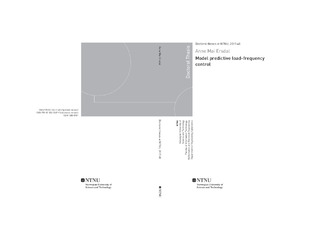| dc.contributor.advisor | Imsland, Lars | |
| dc.contributor.author | Ersdal, Anne Mai | |
| dc.date.accessioned | 2017-03-24T09:45:54Z | |
| dc.date.available | 2017-03-24T09:45:54Z | |
| dc.date.issued | 2017 | |
| dc.identifier.isbn | 978-82-326-2169-9 | |
| dc.identifier.issn | 1503-8181 | |
| dc.identifier.uri | http://hdl.handle.net/11250/2435279 | |
| dc.description.abstract | The decrease in frequency quality seen in the Nordic power system over the past two decades is a clear token of the major changes that power systems all around the world are facing. These changes are to a large extent connected to the green shift in energy production, which results in less controllable power production. Additionally, there are bottlenecks in the Nordic transmission grid, which at times exclude some of the resources from participating in frequency control, and the power trading between the Nordic and the Continental European system is increasing, which means that the Nordic system is being subjected to higher and more unpredictable consumption.
One important mean for improving the frequency quality is to improve the load frequency control (LFC), which is the continuous operation of keeping produced and consumed power equal all times. With the Nordic power system in mind, an important task will be to implement a fully operable automatic generator control (AGC), which automatically controls the power-production set point of each generator. AGC was _rst implemented in the Nordic system in 2013, and due to unexpectedly high expenses, it is still not fully up and running. This thesis aims at investigating model predictive control (MPC) as a control design method for AGC, with application to the Nordic power system. It is believed that the natural handling of multiple inputs and system constraints, as well as the optimizing nature of MPC makes it a promising candidate for AGC.
The main contribution of this thesis is an MPC-based solution to the LFC/AGC problem, where state feedback is achieved through a state estimator and a simpli_ed system model is used both in the MPC predictions and the state estimator. System constraints include production limits and limits on generation rate of change, as well as constraints on tie-line power transfer capacity. In order to include constraints on the individual generating units, and not only on the aggregated generating units of the simpli_ed model, the participation factors of each generator are included as optimization variables. Simulations on a proxy model show that the MPC-based solution outperforms a traditional PI-based solution. In order to make the controller more robust against uctuations in produced wind power, a multi-stage nonlinear MPC (MNMPC) is also presented. Based on estimates of the worst-case deviation in produced wind-power, the MNMPC makes sure there is enough available transfer capacity on tie lines to make use of all resources in case of large deviations in windpower production. The approach of stochastic NMPC (SNMPC) is also tested as an alternative to the MNMPC. The SNMPC has the theoretical advantage of stochastic guarantees for constraint fulfilllment in the presence of disturbances (deviations in produced wind power), while the MNMPC shows better tractability and is less likely to encounter feasibility issues.
Using the power transfer in high voltage direct current (HVDC) lines as controllable inputs to the system is also investigated as a method for improving angle stability, which is a different part of power system stability. The method of backstepping was applied in this part of the thesis, which is a control-design method that is not based on online optimization, contrary to the MPC. The work shows that HVDC-lines can contribute in stabilizing the overall stability of a power system. | nb_NO |
| dc.language.iso | eng | nb_NO |
| dc.publisher | NTNU | nb_NO |
| dc.relation.ispartofseries | Doctoral theses at NTNU;2017:48 | |
| dc.relation.haspart | Ersdal, Anne Mai; Imsland, Lars Struen; Uhlen, Kjetil.
Model Predictive Load-Frequency Control. IEEE Transactions on Power Systems 2016 ;Volum 31.(1) s. 777-785
- © 2016 IEEE. Personal use of this material is permitted. Permission from IEEE must be obtained for all other uses, in any current or future media, including reprinting/republishing this material for advertising or promotional purposes, creating new collective works, for resale or redistribution to servers or lists, or reuse of any copyrighted component of this work in other works
http://doi.org/10.1109/TPWRS.2015.2412614 | |
| dc.relation.haspart | Ersdal, Anne Mai; Imsland, Lars Struen; Uhlen, Kjetil; Fabozzi, Davide; Thornhill, Nina F..
Model predictive load–frequency control taking into account imbalance uncertainty. Control Engineering Practice 2016 ;Volum 53. s. 139-150
https://doi.org/10.1016/j.conengprac.2015.12.001 | |
| dc.relation.haspart | Ersdal, Anne Mai; Imsland, Lars Struen.
Scenario-based approaches for handling uncertainty in MPC for power system frequency control. IFAC-PapersOnLine 2017 ;Volum 50.(1) s. 5529-5535
https://doi.org/10.1016/j.ifacol.2017.08.1094 | |
| dc.relation.haspart | Ersdal, Anne Mai; Imsland, Lars Struen; Uhlen, Kjetil.
Coordinated Control of Multiple HVDC links using backstepping. Proceedings of the IEEE Conference on Control Applications 2012 s. 1118-1123
- © 2012 IEEE. Personal use of this material is permitted. Permission from IEEE must be obtained for all other uses, in any current or future media, including reprinting/republishing this material for advertising or promotional purposes, creating new collective works, for resale or redistribution to servers or lists, or reuse of any copyrighted component of this work in other works
http://doi.org/10.1109/CCA.2012.6402699 | |
| dc.title | Model predictive load-frequency control | nb_NO |
| dc.type | Doctoral thesis | nb_NO |
| dc.subject.nsi | VDP::Technology: 500::Information and communication technology: 550::Technical cybernetics: 553 | nb_NO |
